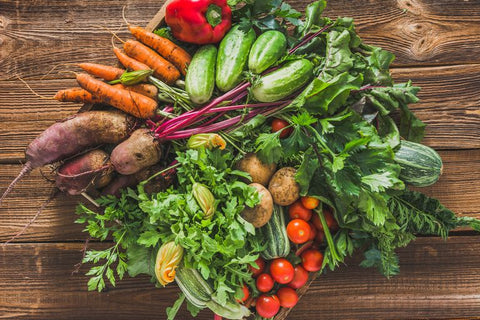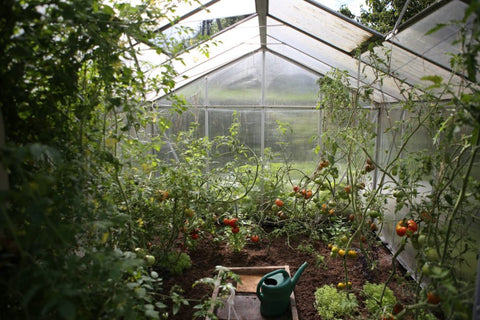As you look outside and watch the leaves begin to change, you may be gearing up to say your goodbyes to summer, and a thriving garden. However, for gardeners looking to stretch out their growing season, the beginning of fall signifies a new opportunity for planting! Late summer and fall is actually one of the best times of year to plant spring-blooming bulbs, cool-season annuals and vegetables, as well as trees, shrubs, and perennials.
You can start vegetable seeds indoors in late summer for transplants for the fall garden, and direct seed many cool-season crops directly into the garden from August through Mid-October!
Cooler temperatures and soaking fall rains will help your plants establish stronger root systems before their winter slumber. For this blog, we will focus on what to plant for the fall season when it comes to vegetables and annuals, so that you don’t have to waste your seeds or slow down your green thumb.
What is Fall Planting?

Fall is a wonderful time of cooler weather, beautiful colors, and seasonal foods. However, the biggest concern we hear is, “Could it be too late to start my own garden?” Luckily, it’s not too late. There are a variety of vegetables that thrive during the fall season, making fall an underrated time to grow. Late September, early October seed planting will see a harvest as early as November 10th. That means homegrown vegetables can be used for festive holiday dinners, on kabobs at football tailgates, or just to nourish your family and friends.
What Vegetables are Best for Fall Planting?
To achieve a successful fall harvest, it’s essential to know your gardening zone. In milder zones, you’ll be able to grow most of the traditional overwintering crops such as root veggies (beets, turnips, potatoes) and brassicas (broccoli, spinach, cauliflower). In hot climates like Texas and Florida, fall and winter are the best times for cool-season crops like lettuces, broccoli, and kale. These won't grow well during the heat of summer, so fall is your time to shine.
As you head further north or into higher altitudes, cold frames and poly tents become your friends for the fall and winter garden. These tools help nurture your plants until the days start to elongate and your first spring vegetables begin to reward you. In very cold climates, you can still keep a fall garden with herbs like basil, oregano, and chives by bringing them indoors next to a south-facing window.

If you live in a colder zone and can’t grow vegetables outdoors during the winter, you can pre-seed your garden for early spring germination. Simply plant the seeds of spring-growing vegetables once it’s too cold for them to germinate, then mulch and wait. Continuously frozen soil over winter is better for the seeds than a cycle of freezing and defrosting. A quick tip: Try spreading more seeds than you think you’ll need, as you can always transplant them or give away extras come spring.
Here are a few ideas for pre-seeded crops: arugula, basil, lettuce, radishes, and brassicas, along with cherry tomatoes and pumpkins. Also, be sure to throw in some milkweed and wildflower seeds so your pollinator friends have something to forage on as soon as the flowers start blooming!
Let’s Talk About Herbs For The Fall
Unless you live in a warmer hardiness zone, you’ll want to bring your herbs inside next to a sunny window for the winter. Don’t worry— with enough light, woody perennials like thyme, sage, and oregano should fare well throughout the winter, especially if you use grow lights. Some herbs we typically grow as annuals are actually biennials. Parsley, dill, and cilantro, for example, grow through spring in warm climates and can be brought indoors to grow through spring in very cold climates.

Fall Planting by Zone
To ensure springtime success with fall-planted vegetables, it’s important to know the growing zone in which you live. This will have a huge impact on what you can and cannot grow. The USDA Hardiness Zones “are the standard by which gardeners and growers can determine which plants are most likely to thrive at a location.” The map is based on the average annual low temperature, divided into 10-degree Fahrenheit zones.
Hardiness Zones 8-11
These zones are optimal for fall gardening, with annual average minimum temperatures of 10°F to 45°F. Areas in these zones include the coasts of Washington, Oregon, and California, as well as the coastal regions of Arizona, New Mexico, Texas, and most of Louisiana, Mississippi, and Alabama. Florida is entirely made up of Zones 8-11, as is central to southern Georgia and South Carolina. Here’s a list of vegetables perfect for fall planting in these zones:
- TURNIPS
- SUMMER SQUASH: First harvest happens 40-55 days after planting, and they are known to be high in antioxidants.
- BROCCOLI: Harvest 75-90 days after planting.
- BELL PEPPERS: These take a bit longer to mature, with the first harvest occurring 80-100 days after planting.
- POTATOES: Ready to harvest in 85-110 days.
- PUMPKIN: The face of fall, this veggie takes the longest to mature with the first harvest happening 90-120 days after planting.

Hardiness Zones 5-7
Zones 5-7 represent quintessential 'Middle America,' proving that temperate climates can also produce fall garden success! Check out these fall vegetables that will grow quickly and be ready for a delicious harvest in time for your holiday festivities:
- SPINACH: Ready for harvest in 40-50 days.
- BEETS: Harvest occurs at 50-65 days.
- CARROTS: Harvest after 55-70 days.
- CAULIFLOWER: Ready for harvest in 55-60 days.
Zones 5-7 thrive with some of the most nutritious vegetable options you can grow in the fall season. Start early so you can enjoy your bounty in all your favorite recipes.
Fall Planting for Spring Harvest
To recap, fall is a great time to plant many vegetables depending on your zone and weather conditions. Spring greens such as spinach, leaf lettuce, arugula, mustard greens, and mâche are great for fall planting because they require cooler soil for seed germination and mature quickly. Fast-growing root veggies such as radishes, beets, and turnips also thrive in cool conditions and take less than two months to mature. And remember, don’t count out your herbs. With the right conditions, like bringing them indoors, ensuring they have enough light, and watering regularly, you will have herbs through the winter and into the spring for all the soups, holiday dishes, and gatherings.









There are no comments for this article. Be the first one to leave a message!